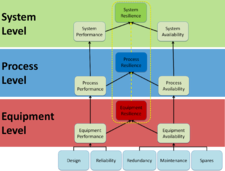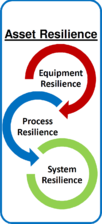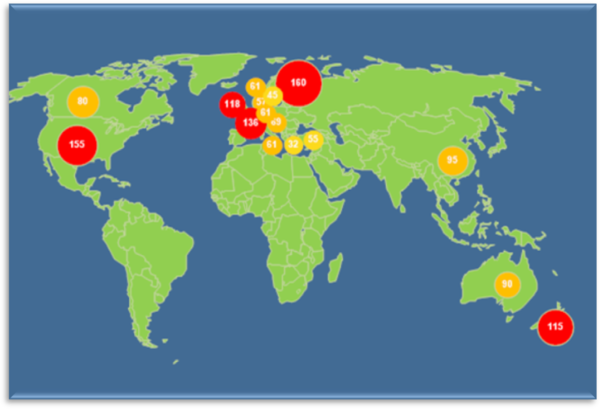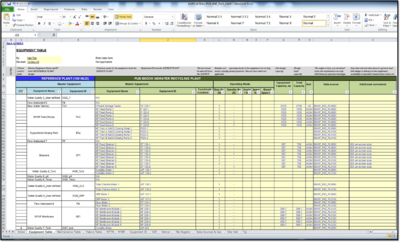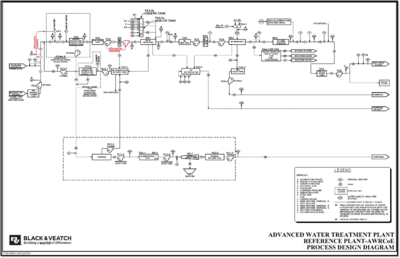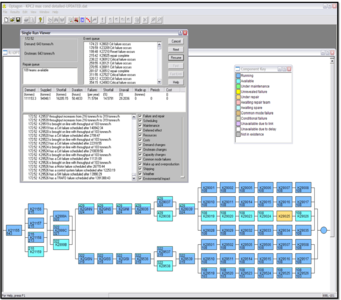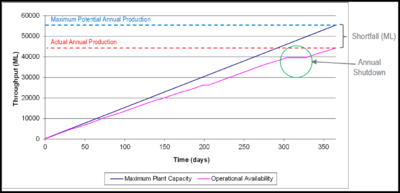Difference between revisions of "Membrane Autopsy Techniques"
From Desal Wiki
(Created page with "Category:Training Material for Operators Category:Resources") |
|||
| Line 1: | Line 1: | ||
| + | ==Purpose== | ||
| + | <div class="align-right"> | ||
| + | <gallery widths=225px heights=225px> | ||
| + | File:Optagon model.png|OPTAGON Model | ||
| + | File:Asset resilience.png|Asset Resilience | ||
| + | </gallery> | ||
| + | </div> | ||
| + | *Resilience is a system’s ability to maintain routine function even under unexpected circumstances.It is an essential factor in ensuring continuous process throughput whilst remaining compliant with strict water discharge guidelines. | ||
| + | *Resilience modelling tools have been widely used in the Petrochemical, Oil and Gas, and Aviation industries to model process reliability and safety over the last 15 years. | ||
| + | *No standard resilience modelling method has been developed for a potable reuse scheme. | ||
| + | |||
| + | *Study used a resilience modelling tool from the Oil and Gas industry, GL Noble Denton’s (GLND) OPTAGON Simulation Package | ||
| + | *OPTAGON is GLND’s Monte Carlo-based Reliability, Availability and Maintainability (RAM) simulation tool which is capable of modelling the performance of asset. | ||
| + | *With user-variated real-time data, OPTAGON is able to accurately predict equipment failure and system resilience. | ||
| + | |||
| + | ==Objective== | ||
| + | *Develop a mechanical resilience model for dual membrane plants (MF/UF + RO) using data from large scale (>10 MLD) plants with long operating history (7-10 yrs) | ||
| + | *Develop “What-if” scenarios for resilience model’s sensitivity based on confirmed cases of drinking water plant failure resulting in pathogen infection | ||
| + | *Quantify process resilience and predict process equipment failure using resilience model. | ||
| + | |||
| + | ==Common Failures in Drinking Water Systems== | ||
| + | *GIDEON database catalogued >2000 confirmed pathogenic outbreaks from 2003 to 2013. | ||
| + | *30% of the outbreaks were associated with protozoan parasites. | ||
| + | *The most common type of failure was an incident in the catchment area in conjunction with an inadequate process design. | ||
| + | *Second most common type of failure occurred in the distribution system followed by an inadequate management framework and operational error. | ||
| + | *Poor asset management and failures highlight the need and importance of resilience modelling in the water industry. | ||
| + | |||
| + | [[File:Gideon map.png|thumb|600px|left]] | ||
| + | |||
| + | <html xmlns="http://www.w3.org/1999/xhtml"> | ||
| + | <head> | ||
| + | <meta http-equiv="content-type" content="text/html; charset=utf-8"/> | ||
| + | <script type="text/javascript" src="//www.google.com/jsapi"></script> | ||
| + | <script type="text/javascript"> | ||
| + | google.load('visualization', '1', {packages: ['corechart']}); | ||
| + | </script> | ||
| + | <script type="text/javascript"> | ||
| + | function drawVisualization() { | ||
| + | // Create and populate the data table. | ||
| + | var data1 = google.visualization.arrayToDataTable([ | ||
| + | ['Pathogen', 'Outbreak (%)'], | ||
| + | ['Bacterial', 23], | ||
| + | ['Protozoan', 30], | ||
| + | ['Viral', 26], | ||
| + | ['Unknown', 9], | ||
| + | ['Mixed Aetiology', 12] | ||
| + | ]); | ||
| + | var data2 = google.visualization.arrayToDataTable([ | ||
| + | ['Causes', 'Failure (%)'], | ||
| + | ['Management', 9], | ||
| + | ['Breakage', 17], | ||
| + | ['Design', 60], | ||
| + | ['Monitoring/Maintenance', 6], | ||
| + | ['Operational/Human Error', 8] | ||
| + | ]); | ||
| + | |||
| + | // Create and draw the visualization. | ||
| + | new google.visualization.PieChart(document.getElementById('visualization1')). | ||
| + | draw(data1, {title:"Pathogen Outbreaks"}); | ||
| + | new google.visualization.PieChart(document.getElementById('visualization2')). | ||
| + | draw(data2, {title:"Causes of Failure"}); | ||
| + | } | ||
| + | |||
| + | |||
| + | google.setOnLoadCallback(drawVisualization); | ||
| + | </script> | ||
| + | <style> | ||
| + | .chart-container { | ||
| + | width: 100%; | ||
| + | margin: 0 auto; | ||
| + | text-align: center; | ||
| + | } | ||
| + | .pie-chart-container { | ||
| + | width: 372px; | ||
| + | margin: 0 auto; | ||
| + | text-align: center; | ||
| + | display: -moz-inline-stack; | ||
| + | display: inline-block; | ||
| + | zoom: 1; | ||
| + | *display: inline; | ||
| + | } | ||
| + | </style> | ||
| + | </head> | ||
| + | <body style="font-family: Arial;border: 0 none;"> | ||
| + | <div class="chart-container"> | ||
| + | <div class="pie-chart-container"> | ||
| + | <div id="visualization1" style="width: 372px; height: 224px;"></div> | ||
| + | </div> | ||
| + | <div class="pie-chart-container"> | ||
| + | <div id="visualization2" style="width: 372px; height: 224px;"></div> | ||
| + | </div> | ||
| + | </div> | ||
| + | </body> | ||
| + | </html> | ||
| + | <p> | ||
| + | |||
| + | ==Supporting Evidence== | ||
| + | |||
| + | ==Modelling Process== | ||
| + | |||
| + | |||
| + | ===Data Sourcing and Collection=== | ||
| + | *Equipment failure and performance data is sourced from 7 water recycling plants worldwide. | ||
| + | *Relevant information is collected from a wide array of data sources. | ||
| + | |||
| + | <!-- Map -> Table --> | ||
| + | |||
| + | ===Data Analysis and Mapping=== | ||
| + | *Cataloged equipment data is sorted and mapped according to process equipment specified in the model (Reference Plant). | ||
| + | *Equipment arranged with design and operational capacities based on functional location. | ||
| + | *Operation & Maintenance (O&M) Manuals provide vital information on equipment availability. | ||
| + | *MTBF and MTTR are also calculated if not previously provided. | ||
| + | *Equipment criticality is determined based on failure and maintenance data. | ||
| + | |||
| + | <center> | ||
| + | <gallery widths=400px heights=300px> | ||
| + | File:Equipment table spreadsheet.png | ||
| + | File:ReferencePlant-AWRCoE-ProcessDesignDiagram.png | ||
| + | </gallery> | ||
| + | </center> | ||
| + | |||
| + | |||
| + | ===Resilience Modelling and Sensitivity Analysis=== | ||
| + | *Mapped data becomes input variables for OPTAGON to model asset’s mechanical resilience. | ||
| + | *Monte Carlo simulations of 10,000 realisations ensure confidence of modelling results. | ||
| + | *Results also demonstrate equipment interdependency. | ||
| + | *Modelling results would quantify the asset’s overall reliability and resilience. | ||
| + | *Sensitivity analysis would further highlight which input variable would have the greatest impact on the system. | ||
| + | *“What-if” scenarios would test the robustness of the reference plant and aid with process optimisation. | ||
| + | |||
| + | <center> | ||
| + | '''Resilience = ƒ (Availability, Performance)'''<br> | ||
| + | '''Availability = ƒ (Reliability, Maintainability)'''<br> | ||
| + | '''Risk = ƒ (Likelihood, Consequence)''' | ||
| + | </center> | ||
| + | |||
| + | ===Outputs=== | ||
| + | *OPTAGON can model complex water recycling systems with high level of accuracy and consistency. | ||
| + | *Modelling results would be able to quantify asset resilience, criticality and risk. | ||
| + | *Resilience modelling can predict and improve asset performance throughout asset’s lifespan. | ||
| + | *Sensitivity analysis would support asset management decisions and aid in efficiency and profitability. | ||
| + | *Reference model can also be used to provide insight to specific failure modes and resulting effects. | ||
| + | |||
| + | <center> | ||
| + | <gallery widths=400px heights=300px> | ||
| + | File:Resilience modelling monte carlo.png | ||
| + | File:Sensitivity analysis.png | ||
| + | </gallery> | ||
| + | </center> | ||
| + | |||
| + | |||
[[Category:Training Material for Operators]] | [[Category:Training Material for Operators]] | ||
[[Category:Resources]] | [[Category:Resources]] | ||
Revision as of 03:14, 4 September 2014
Contents
Purpose
- Resilience is a system’s ability to maintain routine function even under unexpected circumstances.It is an essential factor in ensuring continuous process throughput whilst remaining compliant with strict water discharge guidelines.
- Resilience modelling tools have been widely used in the Petrochemical, Oil and Gas, and Aviation industries to model process reliability and safety over the last 15 years.
- No standard resilience modelling method has been developed for a potable reuse scheme.
- Study used a resilience modelling tool from the Oil and Gas industry, GL Noble Denton’s (GLND) OPTAGON Simulation Package
- OPTAGON is GLND’s Monte Carlo-based Reliability, Availability and Maintainability (RAM) simulation tool which is capable of modelling the performance of asset.
- With user-variated real-time data, OPTAGON is able to accurately predict equipment failure and system resilience.
Objective
- Develop a mechanical resilience model for dual membrane plants (MF/UF + RO) using data from large scale (>10 MLD) plants with long operating history (7-10 yrs)
- Develop “What-if” scenarios for resilience model’s sensitivity based on confirmed cases of drinking water plant failure resulting in pathogen infection
- Quantify process resilience and predict process equipment failure using resilience model.
Common Failures in Drinking Water Systems
- GIDEON database catalogued >2000 confirmed pathogenic outbreaks from 2003 to 2013.
- 30% of the outbreaks were associated with protozoan parasites.
- The most common type of failure was an incident in the catchment area in conjunction with an inadequate process design.
- Second most common type of failure occurred in the distribution system followed by an inadequate management framework and operational error.
- Poor asset management and failures highlight the need and importance of resilience modelling in the water industry.
Supporting Evidence
Modelling Process
Data Sourcing and Collection
- Equipment failure and performance data is sourced from 7 water recycling plants worldwide.
- Relevant information is collected from a wide array of data sources.
Data Analysis and Mapping
- Cataloged equipment data is sorted and mapped according to process equipment specified in the model (Reference Plant).
- Equipment arranged with design and operational capacities based on functional location.
- Operation & Maintenance (O&M) Manuals provide vital information on equipment availability.
- MTBF and MTTR are also calculated if not previously provided.
- Equipment criticality is determined based on failure and maintenance data.
Resilience Modelling and Sensitivity Analysis
- Mapped data becomes input variables for OPTAGON to model asset’s mechanical resilience.
- Monte Carlo simulations of 10,000 realisations ensure confidence of modelling results.
- Results also demonstrate equipment interdependency.
- Modelling results would quantify the asset’s overall reliability and resilience.
- Sensitivity analysis would further highlight which input variable would have the greatest impact on the system.
- “What-if” scenarios would test the robustness of the reference plant and aid with process optimisation.
Resilience = ƒ (Availability, Performance)
Availability = ƒ (Reliability, Maintainability)
Risk = ƒ (Likelihood, Consequence)
Outputs
- OPTAGON can model complex water recycling systems with high level of accuracy and consistency.
- Modelling results would be able to quantify asset resilience, criticality and risk.
- Resilience modelling can predict and improve asset performance throughout asset’s lifespan.
- Sensitivity analysis would support asset management decisions and aid in efficiency and profitability.
- Reference model can also be used to provide insight to specific failure modes and resulting effects.
